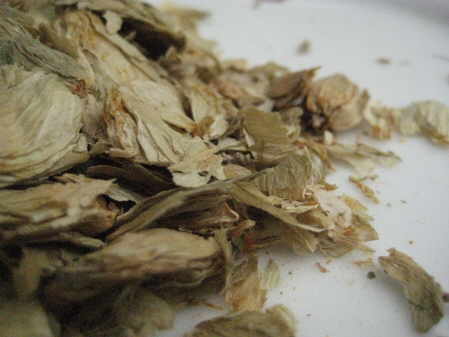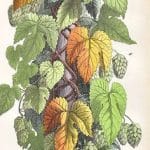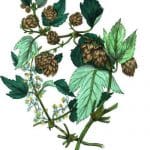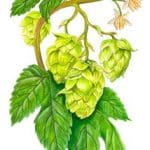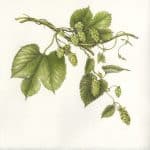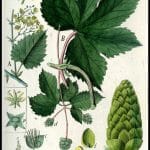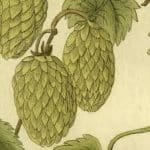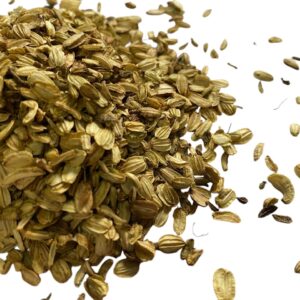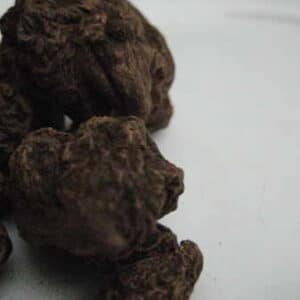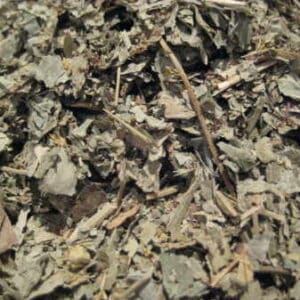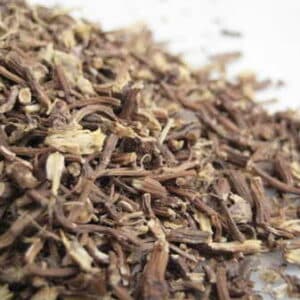Hops or more properly the Hop is a small genus of flowering plants, native to the temperate Northern Hemisphere. The female flowers, commonly called Hops, are used as flavouring and stabilisers during beer brewing.
Although frequently referred to as the Hop vine, it is technically a bine; unlike vines, which use tendrils, suckers, and other appendages for attaching themselves, bines have stout stems with stiff hairs to aid in climbing.
It is a perennial herbaceous plant which sends up new shoots in early spring and dies back to the cold-hardy rhizome in autumn. Hop shoots grow very rapidly and at the peak of growth can grow 2050 cm per week. Hop bines climb by wrapping clockwise around anything within reach, and individual bines typically grow between 2 to 15 m depending on what is available to grow on. The leaves are opposite, with a 712 cm petiole and a cordate-based, palmately lobed blade 1225 cm long and broad; the edges are coarsely toothed. When the hop bines run out of material to climb, horizontal shoots sprout between the leaves of the main stem to form a network of stems wound round each other.
Hops and Brewing
Hop resins are composed of two main acids: alpha and beta acids.
Alpha acids have a mild antibiotic/bacteriostatic effect against Gram-positive bacteria, and favour the exclusive activity of brewing yeast in the fermentation of beer.
Beta acids do not isomerise during the boil of wort, and have a negligible effect on beer flavour. Instead they contribute to beer’s bitter aroma, and high beta acid hop varieties are often added at the end of the wort boil for aroma. Beta acids oxidize and oxidized beta acids form sulfour compounds such as DMS (dimethyl sulfide) that can give beer off-flavours of rotten vegetables or cooked corn.
The flavour imparted by the hop varies by type and use: boiled with the beer (known as “bittering hops”) produce bitterness, while added to beer later imparts some degree of “hop flavour” (if during the final 10 minutes of boil) or “hop aroma” (if during the final 3 minutes, or less, of boil) and a lesser degree of bitterness. Adding hops after the wort has cooled and the beer has fermented is known as “dry hopping”, and adds hop aroma, but no bitterness. The degree of bitterness imparted by hops depends on the degree to which otherwise insoluble alpha acids (AAs) are isomerized during the boil, and the impact of a given amount of hops is specified in International Bitterness Units. Unboiled hops are only mildly bitter.
Flavours and aromas are described appreciatively using terms which include “grassy”, “floral”, “citrus”, “spicy”, and “earthy”. Most of the common commercial lagers have fairly low hop influence, while true pilseners should have noticeable noble hop aroma and certain ales (particularly the highly-hopped style known as India Pale Ale, or IPA) can have high levels of bitterness..
Noble Hops
Noble Hops traditionally refers to four varieties of hop which are low in bitterness and high in aroma. They are the central European cultivars, ‘Hallertauer Mittelfrueh’, ‘Tettnanger’, ‘Spalter’, and ‘Saaz’.
They are each named for a specific region or city in which they were first grown or primarily grown. They contain high amounts of the hop oil humulene and low amounts of alpha acids cohumulone and adhumulone, as well as lower amounts of the harsher-tasting beta acids lupulone, colupulone, and adlupulone. Humulene imparts an elegant, refined taste and aroma to beers containing it.
Their low relative bitterness but strong aroma are often distinguishing characteristics of European-style lager beer, such as Pilsener, Dunkel, and Oktoberfest/Märzen. In beer, they are considered aroma hops (as opposed to bittering hops); see Pilsner Urquell as a classic example of the Pilsener style, which showcases Noble hops.
As with grapes, land where the hops were grown affects the hops’ characteristics. Much like Dortmunder beer may only within the EU be labelled “Dortmunder” if it has been brewed in Dortmund, Noble hops may only officially be considered “Noble” if they were grown in the areas for which the hops varieties were named.
‘Tettnanger’ hops come from Tettnang, a small town in southern Baden-Württemberg in Germany. The region produces significant quantities of hops, and ships them to breweries throughout the world.
History of Hops
The first documented instance of hop cultivation was in 736, in the Hallertau region of present-day Germany (which is today the most important production centre with about 25% of the worldwide production), although the first mention of the use of hops in brewing was in 1079. Hops were introduced to British beers in the early 1500s, and hop cultivation began in the present-day United States in 1629.
Today, the principal production centres for the UK are in Kent (which produces Kent Golding hops) and Worcestershire, and Washington state for the USA; other important production areas include Belgium, as mentioned Germany and the Czech Republic. Other major areas of production include Xinjiang (China), Tasmania (Australia), the Lublin area (Poland) and Chuvashia (Russia). New Zealand is a leading centre for organic hop production.
Until mechanisation (in the late 1960s for the UK), the need for massed labour at harvest time meant hop-growing had a big social impact. Many of those hopping in Kent were Eastenders, for whom the annual migration meant not just money in the family pocket but a welcome break from the grime and smoke of London. Whole families would come down on special trains and live in hoppers’ huts for most of September, even the smallest children helping in the fields. In Kent, hop areas had Oast houses built for drying the hop; many now are converted to homes. The image of Cockney hoppers beneath the blue September skies of the Battle of Britain in 1940 has become part of British national mythology. Romany travellers were another very large group among the hoppers.
| Best Before | August 2027 |
|---|---|
| Harvest | Summer 2024 |
| Batch Code | JF447813a |
| Country of Origin | UK |
